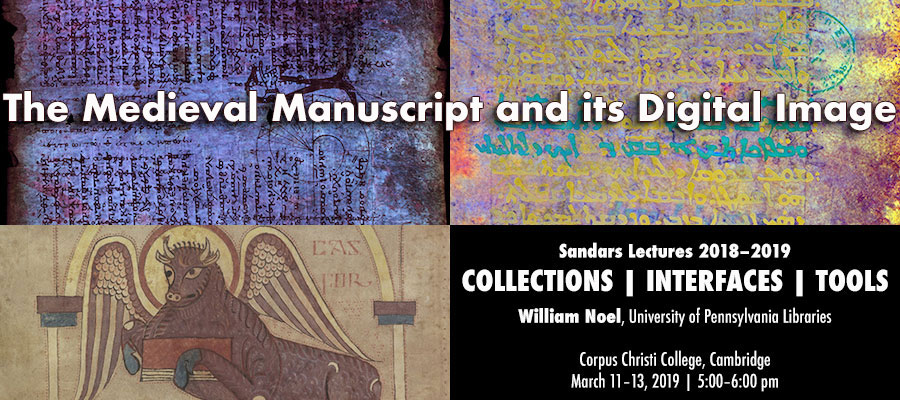The Medieval Manuscript and its Digital Image, Sandars Lectures 2018–2019, lectures by William Noel (University of Pennsylvania Libraries), Corpus Christi College, Cambridge, Lecture 1: March 11, 2019, Lecture 2: March 12, 2019, Lecture 3: March 13, 2019, all lectures 5:00–6:00 pm
These lectures explore the relationship between manuscript pages and digital images, and between physical collections and digital ones. They examine the importance of interfaces in shaping audience and inquiry, and the potential of tools to aid in the archaeology of the medieval book.
Lecture 1: Collections
Digital Images are so good at revealing information about medieval manuscripts that scholars use them all the time. And yet scholars know nothing about most digital images. It is very difficult for to find information about a digital image of a medieval manuscript, other than the shelfmark of manuscript that it represents. This is remarkable for a discipline that prides itself on the careful examination of sources, and it threatens the integrity of scholarship on the medieval book. The personal and institutional presentation of digital images affects not only what scholars can know about the digital images that they use, but also the types of scholarship that they can undertake with them. Through examples such as the Archimedes Palimpsest and the medieval manuscripts of Philadelphia, this lecture reexamines the presentation of digital collections on the web.
Lecture 2: Interfaces
The value of digital images, unlike medieval manuscripts, lies in what you can do with them. The interface through which the images are accessed provide the context in which they are examined, determining the both the ways in which images are studied and used, and the audiences that are likely to use them. The cultural and scholarly value of images therefore changes with the utilities of the interfaces through which they are presented. This lecture examines a wide variety of interfaces for the medieval manuscript image, from multispectral imaging viewers for palimpsests to a crowdsourcing platform for the Cairo Genizah, and illustrates their potential and explores their weaknesses.
Lecture 3: Tools
Digital tools can be used in the service of codicology – the archaeology of the book. This lecture looks at two such tools developed by the Schoenberg Institute of Manuscript Studies at the University of Pennsylvania, that address the fundamentals of medieval book structure, size and format.
Dr William Noel is the Director of the Kislak Center for Special Collections, Rare Books and Manuscripts, and Director of the Schoenberg Institute for Manuscripts Studies at the University of Pennsylvania Libraries.
